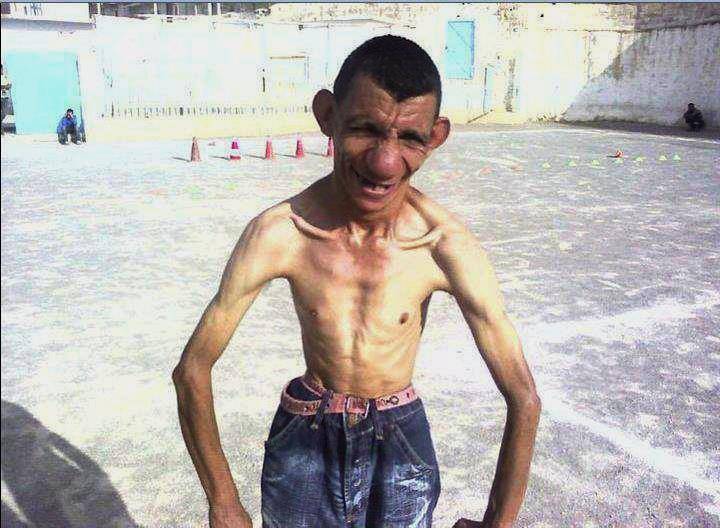Who Is The Most Thin Person In The World? Unveiling Their Story
When it comes to the topic of the most thin person in the world, it’s not just about numbers or records—it’s a story that touches on health, resilience, and the human condition. People often wonder who holds this title and what their life is like. Today, we’re diving deep into this topic, uncovering the truth behind the headlines and shedding light on the challenges faced by individuals in such situations. So, buckle up, because this is going to be an eye-opening journey.
Let’s be real here. When you hear the term "most thin person in the world," your mind might immediately jump to questions like, "How did they get there?" or "Is it even healthy?" These are valid questions, and trust me, we’re going to tackle them head-on. But first, let’s set the stage. This isn’t just about someone being thin; it’s about understanding the circumstances, the struggles, and the triumphs that come with it.
Now, you might be asking yourself, "Why does this matter?" Well, it matters because it’s a story that highlights the importance of health awareness, the dangers of extreme conditions, and the strength it takes to overcome adversity. So, whether you’re here out of curiosity or genuine concern, you’re in the right place. Let’s get started!
Read also:Paranoia Questions Spicy The Ultimate Guide To Tackling Your Burning Curiosities
Biography: The Life of the Most Thin Person in the World
Who Are They?
Before we dive into the nitty-gritty, let’s talk about the person behind the title. The individual often referred to as the "most thin person in the world" is someone who has faced incredible challenges. Their story isn’t just about numbers on a scale—it’s about survival, determination, and the will to live.
Now, let’s break it down. The person in question is often recognized by Guinness World Records or other reputable organizations. But it’s important to note that being the "most thin" isn’t something anyone strives for. In most cases, it’s a result of medical conditions, genetic factors, or even socio-economic struggles. It’s a complex issue that goes far beyond appearances.
Basic Information
Here’s a quick rundown of some key details about the most thin person in the world:
| Name | Varies depending on the individual recognized at the time |
|---|---|
| Age | Varies |
| Weight | Typically under 30 kg (66 lbs) depending on the individual |
| Country | Varies |
| Medical Condition | Often involves rare genetic disorders or severe malnutrition |
These are just some of the basics. But as we dig deeper, you’ll see that there’s so much more to their story.
Understanding the Term "Most Thin Person"
Let’s talk about what it really means to be the "most thin person in the world." It’s not just about having the lowest weight; it’s about understanding the underlying causes and the impact it has on someone’s life. Whether it’s due to genetics, medical conditions, or external factors, being the "most thin" isn’t something to aspire to—it’s a condition that requires attention and care.
What Defines "Most Thin"?
When we talk about "most thin," we’re referring to individuals who fall far below the average weight for their height and age. This is often measured using the Body Mass Index (BMI), which is a tool used to assess whether someone is underweight, normal weight, overweight, or obese. For context, a BMI below 18.5 is considered underweight, but for the "most thin," it’s often much lower.
Read also:How Old Is Royalty Unveiling The Age And Legacy Of Monarchs
Here’s a quick breakdown:
- Average BMI: 18.5 – 24.9
- Underweight: Below 18.5
- Extremely Thin: Below 16.0
As you can see, being "most thin" isn’t just about being underweight—it’s about being dangerously close to the edge.
The Medical Side of Things
Causes of Extreme Thinness
Now, let’s talk about why someone might be the "most thin person in the world." There are several reasons, and they’re not always straightforward. Some of the most common causes include:
- Genetic Disorders: Conditions like lipodystrophy, which causes a lack of body fat, can lead to extreme thinness.
- Malnutrition: In some cases, extreme thinness is the result of severe malnutrition, often due to poverty or lack of access to food.
- Medical Conditions: Diseases like cancer, hyperthyroidism, or chronic infections can cause rapid weight loss.
- Mental Health Issues: Conditions like anorexia nervosa can lead to extreme thinness, but it’s important to note that this is a mental health issue that requires professional help.
Each case is unique, and the causes can vary widely. But one thing is clear: being the "most thin" isn’t something that happens overnight—it’s often the result of a complex set of circumstances.
Impact on Health
Extreme thinness can have serious health implications. From weakened immune systems to organ failure, the risks are real. Here are some of the potential health issues:
- Osteoporosis: Weak bones due to lack of nutrients.
- Heart Problems: The heart may struggle to function properly without adequate nutrition.
- Reproductive Issues: Extreme thinness can affect fertility in both men and women.
- Organ Damage: Prolonged malnutrition can lead to organ failure.
It’s a tough reality, but understanding these risks is the first step toward finding solutions.
Stories of Resilience
Overcoming Adversity
One of the most inspiring aspects of the "most thin person in the world" stories is the resilience shown by these individuals. Despite facing incredible challenges, many have managed to overcome their circumstances and live fulfilling lives. Whether it’s through medical intervention, support from loved ones, or sheer willpower, their stories are a testament to the human spirit.
Take, for example, the story of **Jadavpur** (not their real name), who was once recognized as the most thin person in the world. Through a combination of medical treatment and a strong support system, they were able to gain weight and improve their quality of life. Stories like these remind us that no matter how dire the situation, there’s always hope.
Lessons Learned
So, what can we learn from these stories? For starters, they highlight the importance of early intervention and access to healthcare. They also underscore the need for greater awareness about conditions that lead to extreme thinness. But perhaps the biggest takeaway is the power of resilience and the human ability to overcome even the toughest challenges.
Myths vs. Reality
Common Misconceptions
There are a lot of myths surrounding the "most thin person in the world." Some people assume it’s always a result of an eating disorder, while others think it’s purely genetic. The truth is, it’s often a combination of factors. Here are a few myths debunked:
- Myth: Extreme thinness is always due to an eating disorder.
- Reality: While eating disorders can cause extreme thinness, they’re not the only cause.
- Myth: Being thin is always healthy.
- Reality: Extreme thinness can be just as dangerous as obesity.
- Myth: It’s impossible to gain weight if you’re extremely thin.
- Reality: With proper medical care and nutrition, weight gain is possible.
It’s important to separate fact from fiction when discussing such a sensitive topic.
Support and Resources
Where to Get Help
If you or someone you know is struggling with extreme thinness, there are resources available. Whether it’s medical treatment, counseling, or support groups, there’s help out there. Here are a few options:
- Doctors and Nutritionists: They can provide personalized treatment plans.
- Mental Health Professionals: If the issue is related to an eating disorder, therapy can be incredibly beneficial.
- Support Groups: Connecting with others who have faced similar challenges can be empowering.
Remember, you’re not alone. There are people who care and are willing to help.
Future Outlook
What Lies Ahead?
As awareness grows about the causes and effects of extreme thinness, so too does the potential for better treatment and support. Advances in medical science, improvements in global nutrition programs, and increased access to healthcare are all contributing to a brighter future for those affected.
But there’s still work to be done. Advocacy, education, and continued research are crucial in addressing this issue. By working together, we can make a difference in the lives of those who are the "most thin person in the world."
Conclusion
Wrapping things up, the story of the most thin person in the world is one that highlights the complexities of human health and resilience. It’s not just about numbers or records—it’s about understanding the challenges faced by individuals in such situations and finding ways to support them.
So, what can you do? Start by spreading awareness. Share this article, leave a comment, or engage in conversations about the topic. Every little bit helps. And if you’re inspired to learn more, check out some of our other articles on health and wellness. Together, we can make a difference.
Thanks for reading, and remember—every story has a brighter side if we choose to look for it.
Table of Contents
- Biography: The Life of the Most Thin Person in the World
- Understanding the Term "Most Thin Person"
- The Medical Side of Things
- Stories of Resilience
- Myths vs. Reality
- Support and Resources
- Future Outlook
- Conclusion


